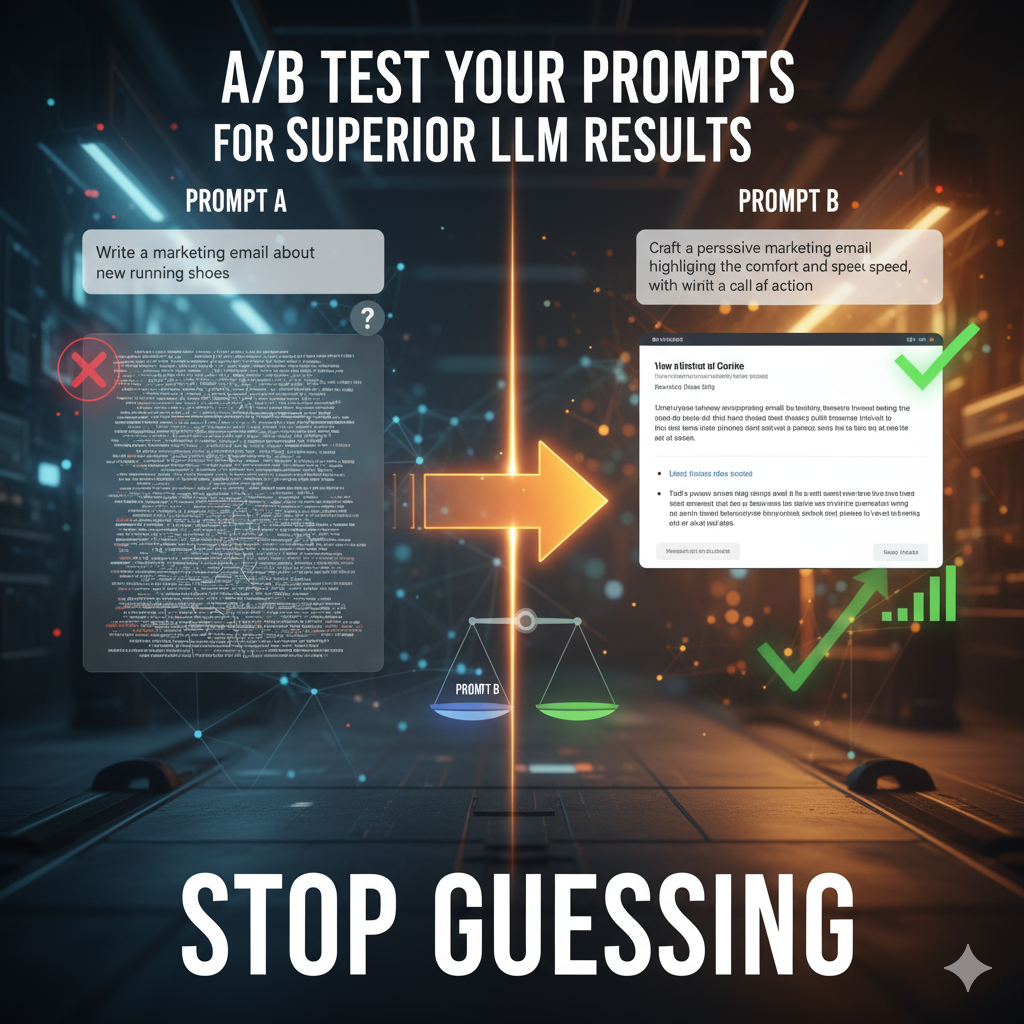When crafting prompts for AI tools like ChatGPT or Claude, most people rely on intuition — tweaking words until something “feels right.” But that approach often leads to inconsistent results.
The smarter alternative? A/B testing your AI outputs.
By systematically comparing two prompt variations and measuring their performance, you can improve accuracy, tone, and creativity with evidence, not guesswork.
If you’re new to prompt experimentation, start with 7 Proven ChatGPT Techniques Every Advanced User Should Know — it covers the foundations of prompt design and iteration.
1. What Is A/B Testing in the Context of AI Prompts?
In marketing, A/B testing compares two versions of a campaign to see which performs better.
In AI, the same logic applies — but instead of testing ads or headlines, you’re testing prompts and outputs.
You create:
- Prompt A: Your baseline version
- Prompt B: A variation (e.g., different phrasing, role, or constraint)
Then, you evaluate which version produces better, more useful outputs.
It’s like turning creative prompt writing into an experimental science.
To understand how prompt design influences outputs, explore How to Use GPTs Like a Pro: 5 Role-Based Prompts That Work.
2. Why A/B Testing Your Prompts Matters
Prompting isn’t static. A prompt that works perfectly today may fail tomorrow as models evolve.
That’s why data-driven iteration is essential — it helps you find what consistently performs best for your specific goals.
Benefits include:
- Clarity: You’ll know why one prompt works better.
- Consistency: Reduce variability in AI responses.
- Efficiency: Save time by focusing on what actually improves results.
You can even track your experiments automatically using Zapier workflows with ChatGPT.
3. How to Set Up Your First A/B Prompt Test
Here’s a simple, repeatable method for running AI A/B tests:
Step 1: Define the goal.
What are you optimizing for? Clarity, creativity, factual accuracy, or tone?
Step 2: Create two prompt variations.
Keep one constant and change a single variable — for example:
- Adding a role (e.g., “Act as a data scientist…”)
- Changing structure (“Give 3 bullet points” vs. “Write a short paragraph”)
- Adjusting constraints (“Use examples from 2024 research”)
Step 3: Run both prompts multiple times.
Because AI outputs vary with randomness, run each prompt at least 3–5 times for fair comparison.
Step 4: Measure outcomes.
Score the results manually or use user feedback to decide which prompt aligns better with your goals.
For inspiration on structured prompt frameworks, check out Prompt Chaining Made Easy: Learn with Real-World Examples.
4. Metrics That Matter in A/B Testing AI Outputs
Quantifying creativity or reasoning can feel abstract — but measurable signals exist.
Here are five metrics to guide your analysis:
| Metric | Description | Example |
|---|---|---|
| Relevance | How closely the output matches your intent | Does the answer solve the task? |
| Readability | How easy it is to understand | Sentence structure, clarity |
| Factual accuracy | Objective correctness | Verified information |
| Conciseness | How efficiently it delivers value | Word count, redundancy |
| Engagement | How actionable or compelling it feels | User reactions or clicks |
To improve these metrics automatically, pair testing with AI analytics tools — explore some of the Top 5 Free AI Tools You Can Start Using Today.
5. Example: A/B Testing in Action
Let’s imagine you’re building an AI writing assistant that generates blog intros.
You test:
Prompt A: “Write an engaging blog introduction about AI automation.”
Prompt B: “Act as a tech journalist. Craft a bold introduction that hooks readers with an AI fact or statistic.”
After five runs, Prompt B scores higher in readability and engagement — meaning it’s your better-performing version.
Repeat the process with new variations until you find the optimal prompt formula.
Want to take it further? Learn how to refine your model responses programmatically in Version Control for Prompts: Tracking What Actually Works.
6. Automating Your A/B Testing Process
You can scale this testing process using automation tools.
For instance:
- Use Google Sheets or Airtable to log prompt-performance data.
- Trigger runs via Zapier or Make.
- Record AI responses, timestamps, and ratings automatically.
This approach turns your experimentation into a repeatable workflow, similar to building an AI + Notion + Zapier workflow.
7. Evolving Your Prompts with Data Feedback
The real power of A/B testing lies in iterative learning.
Once you’ve identified high-performing prompts:
- Combine strong phrasing patterns into new templates.
- Store and reuse them for different projects.
- Regularly re-test as models update (especially after major OpenAI GPT updates).
This cycle mirrors modern AI engineering principles — experiment, measure, and adapt.
Conclusion: Stop Guessing, Start Testing
Prompting isn’t luck; it’s a system you can refine.
A/B testing lets you turn creative prompt writing into data-driven craftsmanship — giving you control over quality, tone, and precision.
By measuring what works instead of guessing, you’ll transform your workflow from reactive to strategic.
And the best part? You can start today — no advanced coding required.
For a deeper dive into building repeatable AI systems, read How to Use GPTs Like a Pro: 5 Role-Based Prompts That Work or The Ultimate Guide to LLM Data Integration: RAG vs Fine-Tuning.



